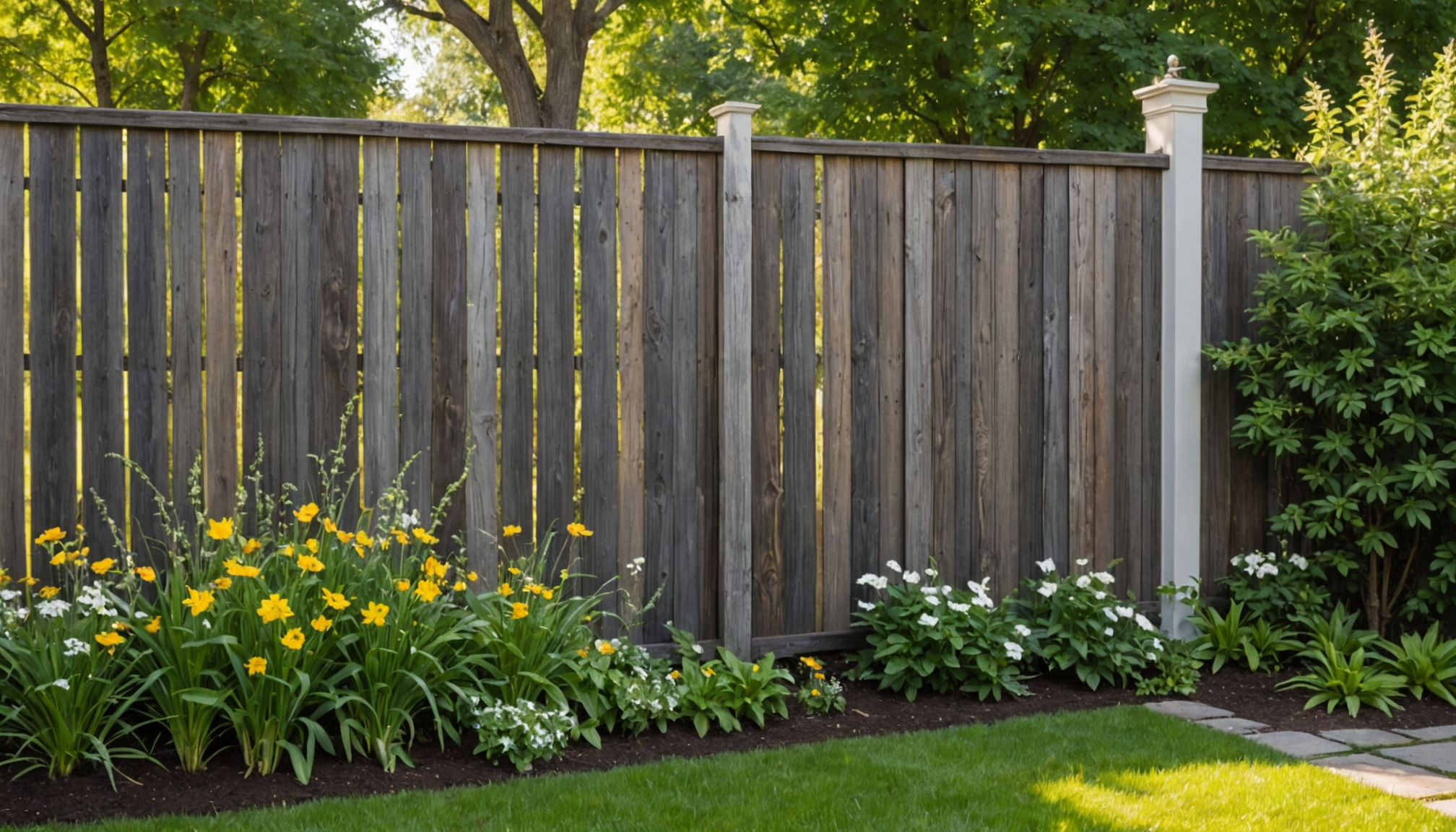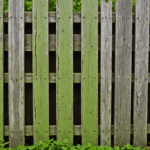When it comes to crafting a standout privacy fence, the choice of materials can significantly influence both the aesthetics and functionality of your outdoor space. Moving beyond traditional choices like wood and vinyl, there’s an array of creative materials that can help you achieve a truly unique fencing design, infusing character and personality while serving the primary purpose of privacy.
One popular option is the use of reclaimed wood. This material not only brings a rustic charm but also tells a story through its weathered look and natural imperfections. From barn wood to pallets, reclaimed wood offers a sustainable way to enhance privacy without sacrificing style. Embracing irregular panel lengths and textures provides a bespoke appearance that contrasts the uniformity of typical fencing materials.
Metal is another versatile option, particularly corrugated metal panels. Known for their durability and industrial aesthetic, these panels can be customized with different finishes, from sleek black to weathered corten steel, complementing both urban and rural settings. Their reflective surface can also add an interesting visual element by playing with light and shadow.
A more artistic approach might involve incorporating bamboo, which offers a fresh and exotic look. Bamboo can be used in various forms, from tightly packed stalks to elegant rolled panels. It is also a fast-growing plant, making it a renewable choice. Bamboo’s slim, tall profile contributes to a serene and natural setting, making it suitable for Asian-themed gardens.
For a modern twist, consider using gabion walls. These are wire cages filled with stones or other materials. Gabions create a strong, bold statement and can be filled with materials of choice to match the surrounding environment. Additionally, the gaps in the fill materials enhance acoustic properties, a beneficial feature for privacy.
To bring a splash of color and artistry into your fencing, indulge in decorative screens. Made from laser-cut metals or perforated panels, these screens offer light and airflow while providing disturbance-free solitude. The intricate patterns can serve as a piece of art within the landscape and pair well with solid materials, like wood or metal, to construct a diversified and artistic appearance.
A table comparing these creative materials can provide a clearer perspective on their distinct characteristics:
| Material | Key Features | Pros | Cons |
| Reclaimed Wood | Rustic, unique patterns | Eco-friendly, cost-effective | May require more maintenance |
| Corrugated Metal | Durable, industrial look | Long-lasting, varied finishes | Can be challenging to install |
| Bamboo | Eco-friendly, exotic | Sustainable, lightweight | Not suitable for all climates |
| Gabion Walls | Strong, customizable | Sound barrier, visually striking | Requires significant space |
| Decorative Screens | Artistic, perforated design | Customizable, airflow-friendly | May be costly |
These creative materials offer an opportunity to blend personal taste with innovative design. By selecting an unconventional material, homeowners can curate an outdoor space that is not only private but also a reflection of personal style, adding character and sophistication to the property.
eco-friendly and sustainable options
When choosing fencing options that contribute positively to the environment while offering effective privacy, there are several innovative and practical choices to consider. These materials not only minimize your carbon footprint but also integrate seamlessly with the natural landscape, creating an inviting outdoor space. Here’s a closer look at eco-friendly and sustainable fencing options and how to incorporate them into your backyard design:
1. Bamboo Fencing
- Selection: Begin by selecting sustainably harvested bamboo, ensuring it’s treated to withstand weather conditions.
- Installation: Bamboo can be installed in panels or stakes. Use a strong framework and ensure the bamboo is elevated above the ground to prevent rot.
- Maintenance: Regularly apply a protective coating to guard against UV rays and moisture.
Bamboo is a highly renewable resource due to its rapid growth rate. Choosing bamboo not only supports sustainable forestry but also adds a natural, exotic aesthetic to your garden.
2. Reclaimed Wood
- Source: Look for suppliers who offer salvaged wood from barns, old buildings, or shipping pallets.
- Preparation: Check for any signs of rot or pest issues; treat the wood as necessary before installation.
- Design: Embrace the rustic appeal by allowing unique nail holes and weathered textures to show.
- Finishing: Apply a weatherproof sealant to prolong the wood’s lifespan.
Reclaimed wood serves as an excellent resource for eco-conscious builders, injecting both character and sustainability into your fence design.
3. Living Fences
- Planning: Choose native or climate-appropriate shrubs or trees that grow densely enough to provide privacy.
- Planting: Space the plants according to the species requirements to ensure they grow into a thick hedge.
- Cultivation: Regular pruning and watering will maintain the density and health of the living fence.
Living fences not only sequester carbon but also provide habitats for local wildlife, contributing to biodiversity in your garden.
4. Composite Fencing
- Materials: Opt for fencing made from recycled plastics and wood fibers, creating durable and eco-friendly panels.
- Installation: Similar in installation to traditional wood fences, composite panels are often crafted to mimic the look of natural wood.
- Longevity: These fences require minimal maintenance, resisting rot and insects naturally.
Composite fencing merges the best of both worlds, providing the appearance of wood while leveraging the resilience and recyclability of plastics.
5. Hempcrete Fencing
- Preparation: Utilize blocks or panels made from hempcrete, a mixture of hemp fibers and lime.
- Construction: Assemble the blocks using traditional masonry techniques.
- Advantages: Hempcrete is lightweight yet durable and acts as a natural insulator, keeping your space serene and private.
This innovative material offers a low-carbon footprint, utilizing a crop that absorbs CO2 rapidly during its growth cycle.
Adopting these eco-friendly fencing options not only contributes to the health of the planet but also enhances the beauty and functionality of your outdoor space, creating a worthwhile investment in sustainable living.
contemporary styles and trends
In today’s world of ever-evolving home aesthetics, privacy fencing has become much more than just a boundary-setting tool. It is a crucial element in shaping outdoor spaces, reflecting contemporary styles and the latest design trends while serving the practical purpose of seclusion. When you’re seeking a modern look, there’s a focus on minimalist elegance, clean lines, and functional elegance that seamlessly integrates with today’s architectural trends.
One of the most dominant trends in contemporary fencing is the use of sleek, horizontal lines. Horizontal slats create a modern aesthetic by providing a sense of direction and flow, making spaces appear more expansive and unified. These fences often utilize materials like hardwood or composite, offering durability along with striking appeal. In addition, horizontal slats can be adjusted in width and spacing, allowing you to customize your level of privacy while maintaining an airy feel.
Another popular trend is the incorporation of mixed materials. This approach combines different elements such as wood with metal or stone, creating a sophisticated contrast that adds texture and depth to your fencing. For example, pairing the warmth of cedar with the sleekness of black aluminum can result in a strikingly modern piece that complements various home exteriors. This blend of materials not only enhances visual interest but also improves durability and reduces maintenance, as materials can be selected for strength and weather resistance in particular areas.
Metallic finishes are also making a substantial impact on contemporary fencing designs. Metals like corten steel and powder-coated aluminum offer an industrial edge that pairs well with urban environments. These metals often develop a unique patina over time, enhancing the rustic, vintage appeal without compromising on modernity. Additionally, the robustness of metal ensures that your fence remains both a stylish and long-lasting investment.
Incorporating greenery within the fence design is another trend reflecting the modern emphasis on sustainability and biophilic design. Vertical gardens or integrated plant boxes can soften the rigid lines of contemporary fences, adding a natural element that boosts the fence’s aesthetic value and ecological benefits. This fusion of natural and man-made materials not only emphasizes the contrast in textures but also promotes biodiversity and purifies the air within close spaces.
Technological integration is reshaping how we think about fencing, with smart materials and high-tech solutions making their way into contemporary designs. For example, incorporating solar lights along your fence can create an elegant nighttime ambiance and improve property security without increasing energy costs. Smart fences with built-in sensors can alert homeowners to disturbances and are perfect for integrating with modern smart home systems for a more connected, efficient home environment.
Contemporary styles in privacy fencing focus on harmony between functionality and design. They ensure your outdoor spaces are not only private but also attractive, reflecting modern design principles that emphasize simplicity, texture, and smart innovation. By embracing these trends, you provide a lasting statement of style that elevates your property’s curb appeal, while also aligning with the architectural aesthetics of today’s living environments.
budget-friendly privacy solutions
Achieving the perfect blend of privacy and cost-effectiveness in your fencing project doesn’t have to be a daunting task. There are remarkably creative and budget-friendly solutions that can provide the seclusion you desire without breaking the bank, contributing to a valuable enhancement of your outdoor space.
One of the most accessible options is using chain-link fences covered with natural elements like climbing plants or privacy slats. While chain-link fences are affordable and easy to install, the addition of climbing vines such as ivy or clematis can add a lush green wall, which not only increases privacy but also enhances aesthetic appeal. Moreover, privacy slats are available in various colors and styles, allowing for an affordable upgrade that customizes your fence’s appearance.
Another cost-effective choice is pallet fencing. Repurposing shipping pallets into a functional fence is not only budget-friendly but also environmentally conscious. Pallets often come free or at a minimal cost from local businesses. By arranging them vertically or horizontally and securing them with basic hardware, you can create a rustic boundary with a unique personality. Applying a fresh coat of paint or wood stain can further protect the wood and elevate the look.
Incorporating lattice panels can also be an economical yet stylish option. Lattice panels offer partial privacy while allowing air and light to filter through, making them perfect for gardens. By attaching these panels to existing structures or standalone posts, you create a charming boundary that encourages climbing plants, which can further enhance privacy over time without a significant investment.
For an innovative solution, consider living fences utilizing fast-growing shrubs or trees like Leyland cypress or privet. Planting a hedge is often a low-cost option that, with a bit of patience, provides excellent privacy and a natural look. These hedges can be shaped and maintained to fit your aesthetic preferences, making them a versatile choice that can adapt to various garden styles.
If you prefer more traditional materials, investing in vinyl fencing can be an economical choice in the long term. Vinyl requires minimal maintenance and is highly durable, often more so than wood. It comes in a variety of styles and colors that mimic the appearance of wood without the added costs of upkeep and frequent repairs.
Additionally, using rope fencing, although more symbolic than solid, can define spaces effectively in a rustic or coastal-themed garden. This type of fencing is highly affordable and easy to install and can be supplemented with a layer of netting or cloth for added privacy in key areas.
It is essential to remember that budget-friendly solutions are not about compromising on quality or style but rather about making smart, creative decisions that maximize your resources. By considering these options, you can achieve privacy, embrace aesthetic preferences, and maintain cost-effectiveness in your fencing project, creating a harmonious balance that meets all your functional and financial needs.
maintenance tips for lasting beauty
To ensure the longevity and appearance of your privacy fence, regular maintenance is crucial. Not only does it preserve the material’s integrity, but it also helps your fence serve its primary function while looking its best.
Firstly, routine inspections are important to identify any issues early on. For wooden fences, be vigilant for signs of rotting, warping, or insect infestation. Check for loose nails or screws and make sure posts are still securely in the ground. If the fence is made of metal, keep an eye out for rust spots, particularly in corners and welded areas, since these are prone to moisture accumulation.
To protect wooden fences, consider applying a sealant or wood preservative every couple of years. This helps prevent moisture penetration and extends the fence’s life. Prior to applying any treatment, ensure the wood is clean and dry. A pressure washer can help remove built-up grime, but be cautious with the pressure to avoid damaging the wood.
Metal fences, such as those made of wrought iron or steel, benefit from a rust-inhibitive primer and paint. Especially if chips and scratches are exposed, touching up these areas will prevent rust from taking hold. Cleaning with mild soap and water is usually sufficient to keep metal looking clean and new.
Composite and vinyl fences, known for their low-maintenance benefits, still require occasional cleaning to maintain their appearance. Simply washing with soap and water can remove dirt and algae. For persistent stains, a mixture of vinegar and water can be effective. Avoid harsh chemicals that can degrade the material over time.
For living fences, regular pruning is essential to maintain their shape and prevent them from becoming overgrown. This also helps improve air circulation within the plants, reducing the likelihood of disease. Make sure to water appropriately, especially during dry periods, to keep the plants healthy and lush.
Regularly check and maintain any hardware, such as hinges, latches, or gates. Lubricating moving parts with suitable oil can ensure they continue to operate smoothly and prevent rust. Adjust or replace parts as needed to maintain proper function and security.
Preventive measures can also help, such as maintaining a buffer zone around the fence base free from soil contact and vegetation, which can trap moisture and contribute to decay. Mulching around living fence bases helps retain moisture and encourages growth, but ensure it does not affect the overall fence structure negatively.
By following these maintenance practices, your fence will remain visually appealing and functional, enhancing your outdoor space for years to come. Efforts invested in care and upkeep are rewarded with prolonged beauty and strength, preserving privacy and adding value to your property.
In conclusion, choosing the right privacy fencing involves balancing aesthetics, sustainability, and budget considerations while keeping long-term maintenance in mind. By exploring creative materials, understanding contemporary styles, and evaluating eco-friendly and economical options, you can tailor a solution that aligns with your vision and lifestyle. Regular care and attention ensure your fence continues to provide the privacy you desire, serving as a lasting testament to your personal style and commitment to quality outdoor living spaces.


